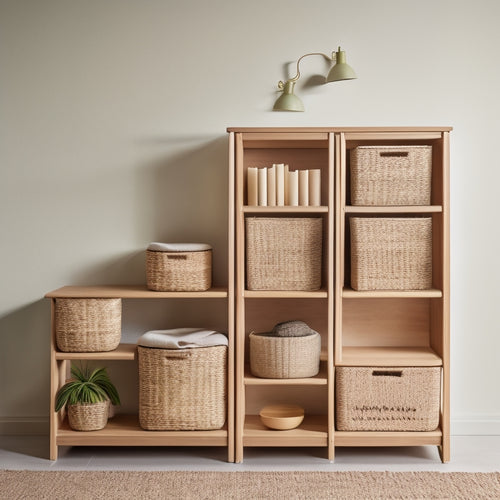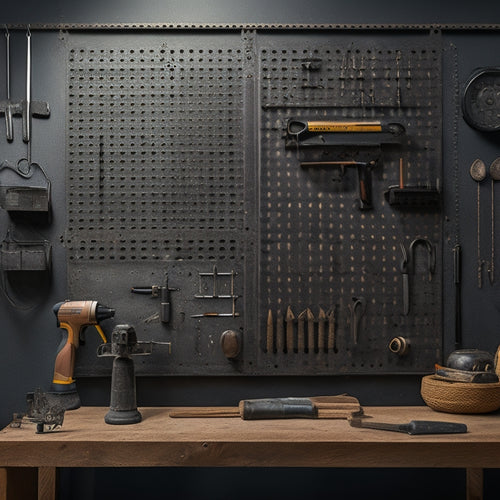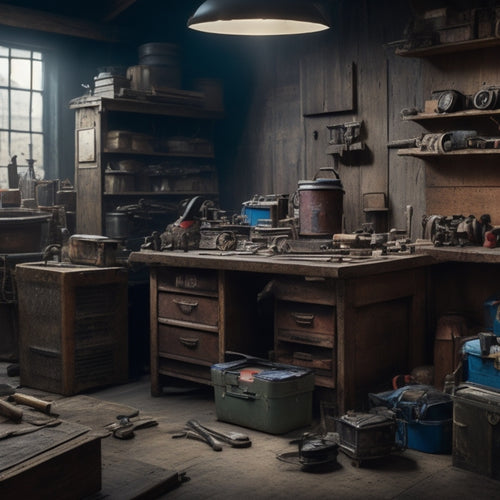
Why a Functional Workshop Layout Plan Matters
Share
By designing a functional workshop layout plan, you can pinpoint and eliminate workflow bottlenecks, maximize space efficiency, and reduce tool search time. A well-planned layout also improves workshop safety standards, streamlines task sequencing, and enhances team productivity. Moreover, it helps minimize downtime causes and optimizes storage capacities, leading to a significant boost in overall performance. By optimizing your workshop layout, you can increase productivity by as much as 20%. Discover the full potential of your workshop and take the first step towards a more efficient and profitable operation - now it's time to explore the strategies that can get you there.
Key Takeaways
• A functional workshop layout plan helps identify and address workflow bottlenecks, reducing delays and improving overall efficiency.
• Maximizing space efficiency through a well-planned layout enhances productivity, reduces clutter, and optimizes storage capacity.
• A well-organized workshop layout reduces tool search time, allowing workers to focus on tasks and complete projects faster.
• A functional workshop layout plan prioritizes safety, reducing risks and hazards, and promoting a culture of accountability.
• By streamlining task sequencing and clustering workstations, a functional workshop layout plan minimizes downtime, increases energy, and fosters collaboration.
Identifying Workflow Bottlenecks
To optimize your workshop's workflow, start by pinpointing the bottlenecks that hinder productivity, as these areas will have the greatest impact on your overall efficiency.
A bottleneck analysis is important in identifying these obstacles, allowing you to visualize your workflow and spot areas where tasks are delayed or stalled. By mapping out your process, you'll be able to identify chokepoints that slow down production, whether it's due to equipment limitations, labor shortages, or inefficient procedures.
Workflow visualization is a powerful tool in this process. It helps you create a clear, graphic representation of your workflow, making it easier to identify areas that need improvement. By analyzing your workflow, you'll be able to pinpoint where tasks are being held up, and make targeted changes to improve productivity.
This might involve streamlining processes, reallocating resources, or investing in new equipment. By tackling these bottlenecks head-on, you'll be able to increase efficiency, reduce waste, and improve your workshop's overall performance.
Maximizing Space Efficiency
With every square foot of your workshop counting, a well-planned layout can greatly enhance your productivity and profitability. When you're working with limited space, it's important to make the most of it. That's where maximizing space efficiency comes in.
You can do this by optimizing your corner utilization. Don't let those often-wasted areas collect dust and clutter. Instead, install shelves, hooks, or a pegboard to store frequently used tools and materials. This will free up floor space and keep your workflow moving smoothly.
Another significant aspect of space efficiency is aisle optimization. Narrow aisles can lead to congestion and accidents, while wide aisles can result in wasted space. Find a happy medium that allows you to move comfortably around your workshop while keeping your tools and materials within easy reach.
Consider a U-shaped layout or a central workstation to create a more efficient workflow. By focusing on corner utilization and aisle optimization, you'll be able to get more done in less space, ultimately boosting your productivity and profitability.
Reducing Tool Search Time
You can cut down on wasted time searching for tools by implementing a structured storage system that keeps everything organized and easily accessible.
This is essential for your personal efficiency, as it allows you to focus on the task at hand rather than wasting precious minutes searching for a specific tool.
A well-planned tool organization system guarantees that every tool has a designated place, making it easy to find what you need when you need it.
This, in turn, helps you complete projects faster and more efficiently.
Improving Workshop Safety Standards
As you design your workshop layout, you'll want to prioritize safety above all else.
You'll need to identify potential hazards and implement strategies to reduce or eliminate them, creating a safe working environment that minimizes risks.
Hazard Reduction Strategies
Identify potential hazards in your workshop by regularly inspecting the space, equipment, and employee behaviors to pinpoint areas that require improvement. This vital approach helps you develop effective hazard reduction strategies, ensuring a safer work environment for your team.
Conduct a thorough risk assessment to identify potential hazards, and then prioritize them based on their severity and likelihood. This will help you focus on the most critical areas that need attention.
Implementing safety protocols is essential in reducing hazards. Here are some strategies to contemplate:
- Provide regular training sessions to educate employees on safe working practices and emergency procedures.
- Ensure all equipment is well-maintained and regularly inspected to prevent mechanical failures.
- Implement a system for reporting and addressing hazards or near-miss incidents.
- Establish clear guidelines for material handling and storage to prevent accidents.
- Create a culture of accountability, encouraging employees to take ownership of safety in the workshop.
Prevention Measures Implemented
By implementing a combination of hazard reduction strategies, workshops can greatly enhance their safety standards through the adoption of preventive measures that address specific hazards and risks.
You'll want to prioritize risk assessment to identify potential dangers in your workshop. This involves evaluating each task, process, and equipment to pinpoint areas that need improvement.
Once you've identified the risks, you can develop targeted prevention measures to mitigate them. For instance, you might implement regular maintenance scheduling to make certain equipment is in good working order, reducing the likelihood of accidents. You may also establish protocols for handling hazardous materials, or provide training on safe lifting techniques.
By being proactive about preventing hazards, you can notably decrease the risk of accidents and injuries in your workshop.
Safe Working Environments
You can create a safe working environment in your workshop by designing a functional layout that promotes efficient workflow, reduces clutter, and guarantees easy access to essential tools and equipment. This not only prevents accidents but also boosts your productivity and overall job satisfaction.
Here are some key considerations to keep in mind:
-
Ergonomic Design: Make sure your workstation is set up to minimize strain on your body, reducing the risk of injury and promoting comfort while working.
-
Place heavy tools and equipment at waist level to avoid straining your back.
-
Designate a specific area for hazardous materials and ensure proper ventilation.
-
Implement a regular cleaning schedule to prevent tripping hazards and keep your workshop organized.
-
Consider the Mental Wellness of yourself and your team by incorporating natural light, comfortable break areas, and minimizing noise pollution.
Streamlining Task Sequencing
Now that you've improved your workshop's safety standards, it's time to focus on streamlining task sequencing to maximize efficiency.
You'll want to optimize task flow, cluster workstations to reduce travel time, and identify process bottlenecks that slow you down.
Task Flow Optimization
To maximize efficiency in your workshop, task flow optimization involves strategically sequencing tasks to minimize downtime, reduce labor costs, and increase productivity. By streamlining task sequencing, you can optimize your workflow and get more done in less time.
Here are some key considerations to keep in mind:
-
Prioritize tasks: Focus on the most critical tasks that require the most resources or have the greatest impact on your workflow.
-
Minimize operator movement: Reduce the distance operators need to travel between tasks to minimize waste and increase productivity.
-
Group similar tasks together: Combine tasks that require similar tools, equipment, or expertise to reduce setup time and increase efficiency.
-
** Sequence tasks logically**: Order tasks in a way that makes sense for your workflow, taking into account factors like material flow and production schedules.
-
Leave room for flexibility: Build in some flexibility to accommodate unexpected changes or setbacks in your workflow.
Workstation Clustering Benefits
By clustering workstations, you can greatly reduce travel time and distance between tasks, resulting in a more streamlined task sequence and increased productivity. This setup allows you to group tasks that require similar resources, skills, or equipment, making it easier to complete tasks efficiently.
When workstations are clustered, you'll spend less time walking between tasks, and more time focusing on the work at hand. This, in turn, reduces fatigue, boosts energy, and enhances your overall work experience.
Clustering workstations also fosters a collaborative culture. When team members are working in close proximity, they're more likely to communicate, share ideas, and support each other. This leads to enhanced morale, as team members feel more connected and valued.
Additionally, clustering workstations encourages cross-training and skill-sharing, as team members can easily observe and learn from each other. By optimizing your workstation layout, you'll not only increase productivity but also create a positive, supportive work environment that motivates your team to excel.
Process Bottleneck Identification
You'll likely find that process bottlenecks, where workflow slows or even grinds to a halt, are often hidden in inefficient task sequences. These bottlenecks can be frustrating and costly, but identifying and addressing them is essential to streamlining your workshop's workflow.
To get started, take a closer look at your task sequences and ask yourself:
- Where are the slowdowns or stoppages occurring?
- Are there any tasks that are consistently delayed or taking longer than expected?
- Are there any tasks that are dependent on other tasks being completed, creating a bottleneck?
- Are there any tasks that require specialized equipment or expertise, limiting capacity?
- Are there any tasks that are prone to errors or rework, adding to the bottleneck?
Enhancing Team Productivity
With a well-designed workshop layout, your team can reduce time-wasting navigation and focus on tackling tasks efficiently, ultimately leading to a significant boost in productivity. This, in turn, allows you to foster a collaborative culture where team members can work together seamlessly, sharing knowledge and expertise to drive results.
By streamlining your workshop's workflow, you can delegate tasks more effectively, ensuring each team member is working on high-priority tasks that align with their strengths. This delegation not only reduces confusion but also empowers team members to take ownership of their work, leading to increased motivation and job satisfaction.
A well-structured workshop layout also enables you to identify areas where team members may need additional training or support. By providing the necessary resources and guidance, you can help your team overcome skills gaps and work more efficiently. As a result, you'll see a significant improvement in overall productivity, allowing your team to complete tasks faster and with greater accuracy.
Minimizing Downtime Causes
In addition to boosting productivity, a well-designed workshop layout also helps you identify and address the common causes of downtime, allowing you to implement targeted solutions that keep your team working efficiently. When you're aware of the potential downtime causes, you can take proactive measures to minimize their impact.
Some common causes of downtime include:
-
Machine failures: Regular maintenance and timely repairs can help reduce machine downtime.
-
Supply shortages: Guarantee you have a steady supply of materials and consumables to avoid work interruptions.
-
Poor communication: Clear communication among team members can help prevent mistakes and misunderstandings that lead to downtime.
-
Inadequate training: Provide your team with the necessary skills and training to operate equipment efficiently and effectively.
-
Inefficient workflows: Streamline your workflows to reduce bottlenecks and minimize downtime.
Optimizing Storage Capacities
By maximizing your workshop's storage capacities, you can efficiently store materials, tools, and equipment, reducing clutter and minimizing the time spent searching for items. This means you'll be able to find what you need quickly, getting projects done faster and more efficiently.
To achieve this, focus on effective inventory management. Take stock of your supplies, tools, and equipment, and categorize them based on frequency of use, size, and type. This will help you allocate shelf space wisely, ensuring that frequently used items are easily accessible and less frequently used items are stored out of the way.
Consider a 'first in, first out' approach to prevent older materials from getting lost or forgotten. Additionally, label your shelves and storage bins clearly, making it easy to identify what's inside.
Boosting Overall Performance
You can greatly enhance your workshop's overall performance by streamlining your workflow, eliminating unnecessary steps, and implementing efficient processes that save time and energy. When you have a well-planned layout, you can focus on what matters most - producing high-quality products and delivering them on time. This, in turn, will improve your Production Metrics and Performance Analytics.
Here are some ways a functional workshop layout plan can boost overall performance:
-
Reduce Wasted Time: With a clear and organized workspace, you'll spend less time searching for tools and materials, and more time on actual production.
-
Increase Productivity: Efficient processes and workflows enable you to complete tasks quickly and efficiently, resulting in increased productivity.
-
Improve Employee Morale: A well-designed workshop layout plan can reduce stress and frustration, leading to a more positive and motivated workforce.
-
Enhance Quality Control: With a clear and organized workspace, you can better monitor and control the quality of your products.
-
Increase Customer Satisfaction: By delivering high-quality products on time, you'll increase customer satisfaction and loyalty.
Frequently Asked Questions
Can a Functional Workshop Layout Plan Be Adapted to Existing Spaces?
You can adapt a functional workshop layout plan to your existing space by identifying space constraints and optimizing the room to suit your needs, allowing you to work efficiently despite limitations.
How Often Should Workshop Layout Plans Be Reassessed and Updated?
'As you navigate the ever-shifting landscape of your workshop, you'll find that reassessing and updating your layout plan every 6-12 months is vital for effective change management and space optimization, ensuring your space stays efficient and productive.'
Are There Any Industry-Specific Workshop Layout Plan Considerations?
You'll encounter unique challenges in food processing, where sanitation and contamination control drive layout decisions, and in aerospace manufacturing, where precision and specialized equipment demand tailored layouts that guarantee efficient production and quality control.
Can a Functional Workshop Layout Plan Improve Employee Morale?
"As you step into your workshop, imagine a space that fuels your team's energy. A functional layout plan can do just that, yielding a productivity boost and nurturing mental wellness, ultimately lifting employee morale and igniting a sense of pride."
Are There Any Specific Software or Tools for Designing Workshop Layouts?
You can utilize design software like Autodesk's AutoCAD or SketchUp to create a workshop layout, focusing on space optimization to maximize efficiency and productivity, ensuring a smooth workflow and reducing costs.
Related Posts
-

Open Storage Bins for Shelving Units
You need open storage bins that integrate seamlessly with your shelving units to boost your organization, productivit...
-

Heavy-Duty Pegboard Hooks for Industrial Use
You need heavy-duty pegboard hooks that can withstand the rigors of industrial use, providing a reliable and efficien...
-

10 Best Tool Boxes for Every Budget and Job
You're looking for a tool box that fits your budget and job requirements. Whether you're a DIY enthusiast, electricia...


